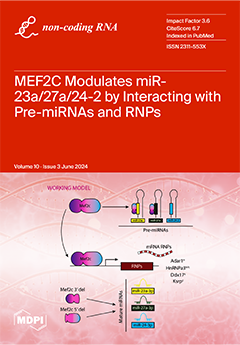Small RNAS (sRNAs) participate in regulatory RNA interference (RNAi) mechanisms in a wide range of eukaryotic organisms, including fungi. The fungus
Fusarium fujikuroi, a model for the study of secondary metabolism, contains a complete set of genes for RNAi pathways. We have
[...] Read more.
Small RNAS (sRNAs) participate in regulatory RNA interference (RNAi) mechanisms in a wide range of eukaryotic organisms, including fungi. The fungus
Fusarium fujikuroi, a model for the study of secondary metabolism, contains a complete set of genes for RNAi pathways. We have analyzed by high-throughput sequencing the content of sRNAs in total RNA samples of
F. fujikuroi grown in synthetic medium in the dark or after 1 h of illumination, using libraries below 150 nt, covering sRNAs and their precursors. For comparison, a parallel analysis with
Fusarium oxysporum was carried out. The sRNA reads showed a higher proportion of 5′ uracil in the RNA samples of the expected sizes in both species, indicating the occurrence of genuine sRNAs, and putative miRNA-like sRNAs (milRNAS) were identified with prediction software.
F. fujikuroi carries at least one transcriptionally expressed Ty1/copia-like retrotransposable element, in which sRNAs were found in both sense and antisense DNA strands, while in
F. oxysporum skippy-like elements also show sRNA formation. The finding of sRNA in these mobile elements indicates an active sRNA-based RNAi pathway. Targeted deletion of
dcl2, the only
F. fujikuroi Dicer gene with significant expression under the conditions tested, did not produce appreciable phenotypic or transcriptomic alterations.
Full article






